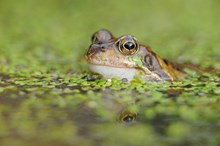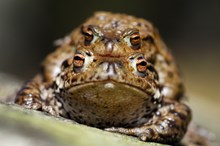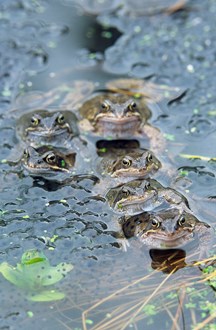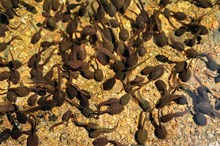26 March, 2019
Helping tadpoles grow up into gardeners’ friends
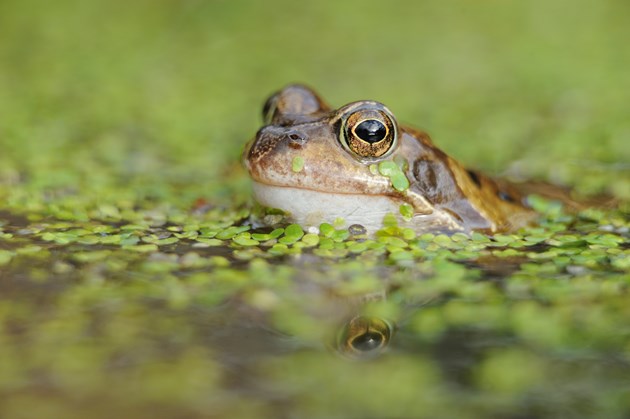
Gardeners peering into ponds at this time of year could be in for a nice surprise. The thick, jelly-ish clumps of frog spawn floating free and long strings of toad spawn, wrapped around water plants, will soon turn into a mass of wriggling tadpoles. And with a bit of help, they can grow up to be gardeners’ friends - slug and snail-devouring frogs and toads.
Tadpoles can be found everywhere on mainland Scotland in early spring, even in built up areas - including our biggest cities. The best places to look are in ponds and ditches.
Dr Mairi Cole, who manages the species team at Scottish Natural Heritage, shares some fun facts about tadpoles:
- The highest altitude a common frog tadpole has been found at in Scotland was in a loch at the top of Ben Macdui – 1120m up!
- The speed at which tadpoles develop depends on the water temperature. The fastest developing tadpoles in Scotland are natterjack toad tadpoles. They can turn from an egg into a tiny toad in as little as three weeks, although it usually takes longer in our cold Scottish summers. In Scotland, natterjacks - so called because of the loud rasping call made by the male toad in the spring - are only found on a few sites on the Solway Firth.
- At first the tadpoles of frogs and toads are difficult to tell apart but it gets easier as they get older. Frog tadpoles are speckled and toad tadpoles are a dark colour.
- It’s a tough life for a tadpole. Only a tiny number of the thousands of eggs that are laid in a pond each year make it to adulthood. They get eaten by dragonfly larvae, newts and fish and are vulnerable to diseases.
- Toad tadpoles are protected from predators by having a poisonous skin. In the 1970’s, an American lecturer got his students to do a taste test – and yes, they tasted disgusting!
- Meanwhile, in South America, the tadpole of the appropriately-named paradox frog is bigger than the adult frog. The tadpole is 25cm long - and the frog is 7cm!
Mairi said: “I love looking out for spawn and tadpoles when I’m out and about at this time of year. It’s amazing watching them grow from little eggs into tadpoles and then, if they are lucky, into tiny frogs and toads.
“Frogs and toads are our friends, particularly in the garden. They love eating slugs, snails, ants and spiders. And they are food for other animals and birds like blackbirds, hedgehogs, foxes and badgers. They are also good indicators of the health of the wider countryside as they have a porous skin that is sensitive to pollutants.
“If you have a garden, making a small pond is one of the best ways to help them. Don’t have fish in there too, though - they not only eat tadpoles, they can pass on disease. Cut down on the use of pesticides around your garden, especially slug pellets. And drive carefully if you come across toads crossing the road – they often travel back to the same ponds to breed each year in the late winter and early spring and will cross whatever is on their route – including roads. So keep your eyes peeled – and happy spotting!”
ENDS
Media enquiries: Contact the SNH press office on 0131 316 2655 or snhmedia@nature.scot
Contact information
- Name
- NatureScot Media
- Telephone
- 0131 316 2655
- media@nature.scot
NatureScot is Scotland's nature agency. We work to enhance our natural environment in Scotland and inspire everyone to care more about it. Our priority is a nature-rich future for Scotland and an effective response to the climate emergency. For more information, visit our website at www.nature.scot or follow us on X at https://x.com/NatureScot
’S e NatureScot buidheann nàdair na h-Alba. Bidh sinn a’ neartachadh àrainneachd na h-Alba agus a’ brosnachadh dhaoine gu barrachd suim a chur ann an nàdar. Tha e mar phrìomhachas againn gum bi nàdar na h-Alba beairteach agus gun dèilig sinn gu h-èifeachdach le èiginn na gnàth-shìde. Tha an tuilleadh fiosrachaidh aig www.nature.scot no air X aig https://x.com/NatureScot

